Comparative studies of lepidopteran baculovirus-specific protein FP25K: development of a novel Bombyx mori nucleopolyhedrovirus-based vector with a modified fp25K gene
- PMID: 20219904
- PMCID: PMC2863835
- DOI: 10.1128/JVI.00099-10
Comparative studies of lepidopteran baculovirus-specific protein FP25K: development of a novel Bombyx mori nucleopolyhedrovirus-based vector with a modified fp25K gene
Abstract
Lepidopteran baculovirus-specific protein FP25K performs many roles during the infection cycle, including functions in the production of occlusion bodies (OBs) and budded viruses (BVs), oral infection, and postmortem host degradation. To explore the common and specific functions of FP25K proteins among lepidopteran baculoviruses, we performed comparative analyses of FP25K proteins from group I and group II nucleopolyhedroviruses (NPVs) and granulovirus (GV). Using recombinant Bombyx mori NPVs (BmNPVs), we showed that the FP25Ks from NPVs were able to eliminate all the phenotypic defects observed in an infection with a BmNPV mutant lacking functional fp25K but that FP25K from GV did not show abilities to recover oral infectivity and postmortem host degradation. We also observed that introduction of Autographa californica multiple NPV (AcMNPV) fp25K into the BmNPV genome enhanced OB and BV production. According to these results, we generated a novel BmNPV-based expression vector with AcMNPV fp25K and examined its potential in BmN cells and B. mori larvae. Our results showed that the introduction of AcMNPV fp25K significantly increases the expression of foreign gene products in cultured cells and shortens the time for obtaining the secreted recombinant proteins from larval hemolymph.
Figures
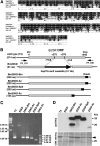
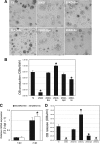
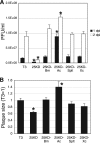
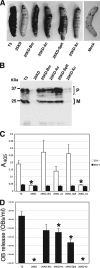

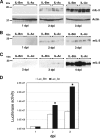
Similar articles
-
Reduced cysteine protease activity of the hemolymph of Bombyx mori larvae infected with fp25K-inactivated bombyx mori nucleopolyhedrovirus results in the reduced postmortem host degradation.Arch Virol. 2004 Sep;149(9):1773-82. doi: 10.1007/s00705-004-0328-5. Arch Virol. 2004. PMID: 15593419
-
Bombyx mori nucleopolyhedrovirus ORF34 is required for efficient transcription of late and very late genes.Virology. 2009 Sep 30;392(2):230-7. doi: 10.1016/j.virol.2009.07.003. Epub 2009 Aug 3. Virology. 2009. PMID: 19651423
-
Bombyx mori nucleopolyhedrovirus FP25K is essential for maintaining a steady-state level of v-cath expression throughout the infection.Virus Res. 2009 Mar;140(1-2):155-60. doi: 10.1016/j.virusres.2008.11.014. Epub 2009 Jan 8. Virus Res. 2009. PMID: 19100790
-
Transgenesis approaches for functional analysis of peptidergic cells in the silkworm Bombyx mori.Gen Comp Endocrinol. 2009 May 15;162(1):36-42. doi: 10.1016/j.ygcen.2008.11.028. Epub 2008 Dec 10. Gen Comp Endocrinol. 2009. PMID: 19111552 Free PMC article. Review.
-
Post-translational modification of baculovirus-encoded proteins.Virus Res. 2020 Apr 2;279:197865. doi: 10.1016/j.virusres.2020.197865. Epub 2020 Jan 24. Virus Res. 2020. PMID: 31987850 Review.
Cited by
-
Removal of transposon target sites from the Autographa californica multiple nucleopolyhedrovirus fp25k gene delays, but does not prevent, accumulation of the few polyhedra phenotype.J Gen Virol. 2010 Dec;91(Pt 12):3053-64. doi: 10.1099/vir.0.024430-0. Epub 2010 Sep 1. J Gen Virol. 2010. PMID: 20810745 Free PMC article.
-
BV/ODV-E26 is a conserved baculoviral inhibitory factor for optimizing viral virulence in lepidopteran hosts.iScience. 2024 Dec 31;28(2):111723. doi: 10.1016/j.isci.2024.111723. eCollection 2025 Feb 21. iScience. 2024. PMID: 39898022 Free PMC article.
-
Specific nucleotide substitutions in the burst sequence enhance polyhedrin expression in alphabaculoviruses: improvement of baculovirus expression vectors.Appl Environ Microbiol. 2025 May 21;91(5):e0014425. doi: 10.1128/aem.00144-25. Epub 2025 Apr 7. Appl Environ Microbiol. 2025. PMID: 40192296 Free PMC article.
-
Genetic modification of baculovirus expression vectors.Virol Sin. 2012 Apr;27(2):71-82. doi: 10.1007/s12250-012-3236-y. Epub 2012 Apr 11. Virol Sin. 2012. PMID: 22491998 Free PMC article. Review.
-
Baculovirus-encoded protein BV/ODV-E26 determines tissue tropism and virulence in lepidopteran insects.J Virol. 2012 Mar;86(5):2545-55. doi: 10.1128/JVI.06308-11. Epub 2011 Dec 21. J Virol. 2012. PMID: 22190721 Free PMC article.
References
-
- Beames, B., and M. D. Summers. 1989. Location and nucleotide sequence of the 25K protein missing from baculovirus few polyhedra (FP) mutants. Virology 168:344-353. - PubMed
-
- Braunagel, S. C., S. T. Williamson, S. Saksena, Z. Zhong, W. K. Russell, D. H. Russell, and M. D. Summers. 2004. Trafficking of ODV-E66 is mediated via a sorting motif and other viral proteins: facilitated trafficking to the inner nuclear membrane. Proc. Natl. Acad. Sci. U. S. A. 101:8372-8377. - PMC - PubMed
-
- Chakraborty, S., and S. Reid. 1999. Serial passage of a Helicoverpa armigera nucleopolyhedrovirus in Helicoverpa zea cell cultures. J. Invertebr. Pathol. 73:303-308. - PubMed
-
- Clem, R. J., M. Fechheimer, and L. K. Miller. 1991. Prevention of apoptosis by a baculovirus gene during infection of insect cells. Science 254:1388-1390. - PubMed
Publication types
MeSH terms
Substances
LinkOut - more resources
Full Text Sources
Miscellaneous

